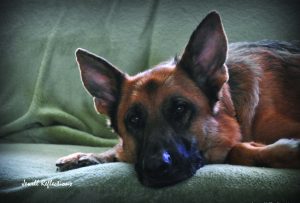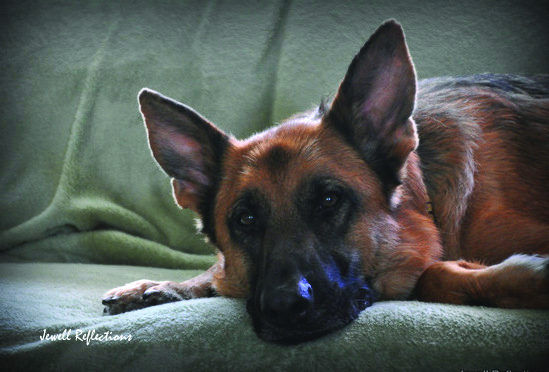BY FRAN JEWELL

Most people think separation anxiety occurs when their dog becomes destructive when they leave the dog home alone. The reality is that separation anxiety begins long before that. Sometimes it begins when a dog starts following an owner around the house, never letting the owner out of its sight. Other clues about the beginnings of separation anxiety can be a dog that constantly asks for petting or leans continually on the owner. The dog may even sleep on the owner’s feet or constantly “needs” to be in bed with its owner. Feeling that this is affection, or “bonding,” many owners freely return the demand for affection, unknowingly engaging the dog in further “needy” behavior and dependence upon the owner to soothe the dog’s discomfort.
In essence, this is a clash of our basic species characteristics. What we humans see as affection and support and nurturing can in fact be devastating to an insecure dog, furthering the dog’s dependence and ultimately creating fear and anxiety in simple daily living. The more nurturing we see ourselves and the more we adore the dog’s need for us, the worse the dog’s anxieties can become, the more dependent the dog may become.
At this point it becomes incredibly tempting to take your dog with you so it doesn’t feel left out or destroy the house. Then, all of a sudden, leaving the dog in the car while an owner runs into the store becomes a barking nightmare while the dog screams for the owner to return, terrified of being left alone. The owner quickly returns to the dog to stop the barking which, unfortunately, lets the dog know that barking is a successful way to get the owner to come back to the car and even further perpetuates its dependence upon the owner. Pretty soon the owner cannot leave the dog in the car at all, because now the barking has turned into tearing up the interior of the car when the dog is overwhelmed with fear.
Simple everyday tasks become a nightmare for the owner because the dog has become so destructive, afraid or anxious while the owner is gone.
Where this all began is in the very simple gestures that are unrecognizable as demands for petting and subsequent cooperation by the owner. The owner unwittingly tells the dog in those simple gestures that he likes the dog’s needy behaviors. The need becomes obsession, and the obsession becomes dangerous anxiety attacks for the dog when its owner is gone even for brief moments.
While not petting the dog is not the answer, paying attention to how we humans nurture independence is important. Petting and giving love to a dog that is lying nicely in its bed by the fireplace lets the dog know that you like him comfortable by himself. Calling the dog over when the dog is engaged in independent behavior to give him pets still allows the owner to be affectionate, but nurtures the dog’s independence. Have a party when leaving the house, with special treats, instead of having a greeting party when returning. It lets the dog know that the owner being gone is a good thing. Coming home should be no big deal and not worth the anxiety of anticipation.
While separation anxiety is a huge problem for many dog owners, it can be helped with dedication and consistency. Most of the time it can be prevented. Seeing the signs early can help us to examine our behaviors with our dog to see if we are encouraging healthy independence or dependence. Once it has started, an owner must be willing to potentially make changes in the way they demonstrate their affection, among other important things.
As with almost all canine behavior problems, an ounce of prevention is always worth a pound of cure—and new furniture or car interiors! If you see the beginnings of separation anxiety, seek qualified professional help before the problem becomes dangerous and very difficult to stop. Seek canine professionals with certifications from well-known organizations with extensive experience.
Fran Jewell is an Idaho Press Club award-winning columnist, IAABC-certified dog behavior consultant, NADOI-certified instructor #1096 and the owner of Positive Puppy Dog Training, LLC, in Sun Valley. For more information, visit positivepuppy.com or call (208) 578-1565.



